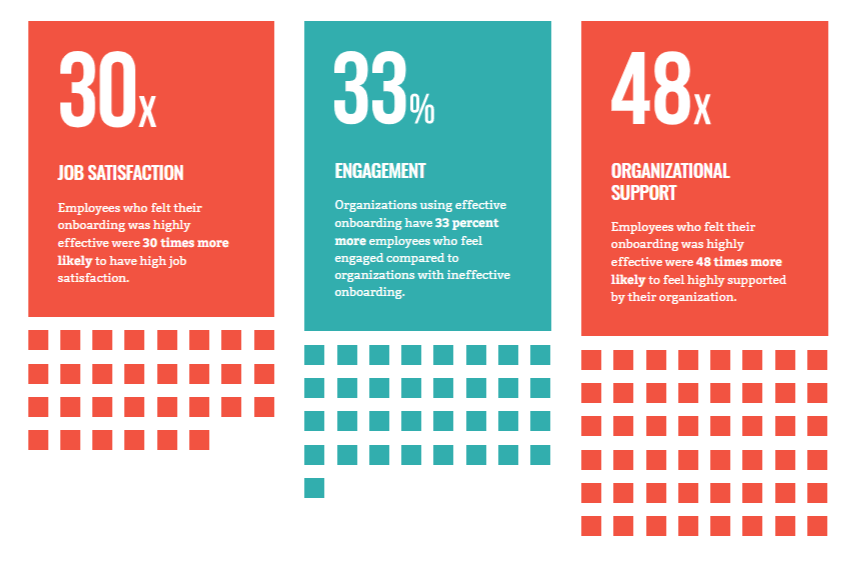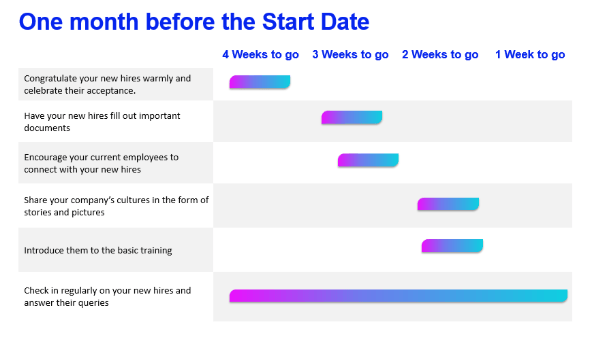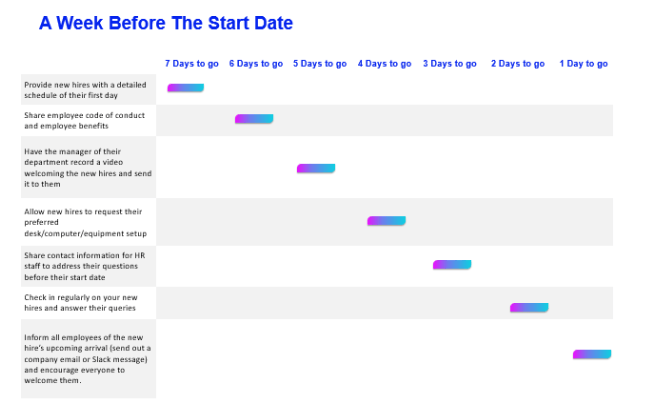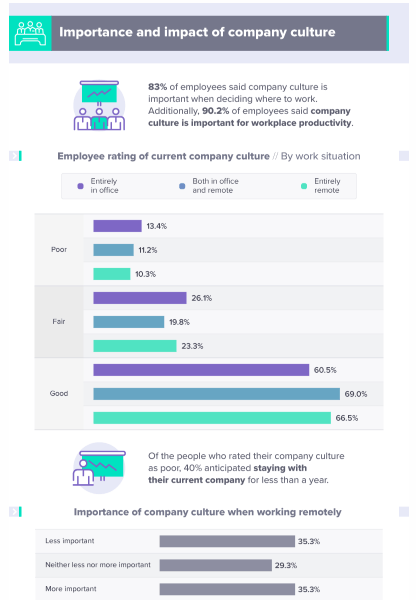Effective onboarding helps new hires gain the necessary skills and aligns their efforts with the organization’s objectives. It helps new employees feel engaged, committed, supported, and connected to the organization. As evident in the infographic shown below, a positive onboarding experience contributes to improved job satisfaction and employee engagement.
Organizations that care about upholding their culture and values, invest their resources in creating an effective onboarding experience for their employees. However, onboarding remote employees is a whole new ballgame.
Hiring and onboarding employees virtually is a tricky undertaking. That’s because organizations often struggle with introducing effective communication channels, creating a feeling of camaraderie, designing engaging training modules, and offering job clarity to the new hires. Further, virtual onboarding is a new concept for most firms who were forced to adopt the remote way of working against the backdrop of the pandemic.
As a result, organizations are still experimenting with various strategies to get and retain virtual new hires on board in the most effective way possible. However, onboarding virtual employees needs to be done with care, especially when the cost of losing an employee is phenomenal.

A sloppy and unstructured onboarding process is the number one reason why new hires quit within the first three months. Pay attention to the common pitfalls that can ruin the onboarding process for new remote hires and take proactive steps to avoid them before they negatively affect your reputation and profits.
1. Not having a pre-boarding process
Even for a remote new hire, day one at work can be challenging as they do not have a co-worker or a senior to informally guide them on the acceptable behavior, company policies, the roles and responsibilities, or the training schedule. This can make the new hire feel disconnected, dampening their excitement on day 1.
Did you know that 4 percent of new hires leave a job after a disastrous first-day experience?
Also, a newly-chosen candidate is still anxious about switching jobs.
They are doubtful whether or not they have made the right career choice by joining you. The wide range of emotions like anxiety, self-doubt, and hope makes it easy for them to change their mind and join elsewhere.
Having a strong pre-boarding process in place can eliminate such jitters and make the onboarding process easy and effective. Further, it solidifies the new hire’s commitment to the company, encouraging them to stay with you.
1. Send a welcome email
Nothing can prime your new remote hire for the onboarding process like a welcome email. The email should share the schedule planned for the first day and the documents the remote hire should be ready with. It should also include details on work-life at the organization, pictures of the team, and an invitation to join the company’s social media group.
2. Focus on the pre-boarding essentials


Set new hires up for success even before they see you on the first day of the onboarding process by engaging them through the pre-boarding phase (the time when the candidate accepts the job offer to the first day of working).
Simply put, if you have some time between contract signing and onboarding, have a clear plan to prepare them and drum up some excitement. Check out this simple one-month and one-week pre-boarding plans that can help your new hire feel welcome.
3. Avoid information overload
Though it’s critical to share the required information with the new hire, remember to keep it concise and relevant to their role. Sharing too much or irrelevant information can burden them unnecessarily and cause confusion.
2. Underrating the importance of company culture
Statistics reveal that 66 percent of the employees are working from home, of which 44 percent works remotely for five days or more (as of April 2020). The virtual way of working is presenting employees and employers with newfound challenges and demands. In such a scenario, a positive company culture can help boost employee morale, productivity, and staff retention.
A recent survey of 1,031 employees conducted by Nulab, a software company, revealed the importance of upholding company culture in this era of uncertainty. 83 percent of the respondents rated company culture as a critical factor when deciding to work.

So, you got to do more than just showing a PowerPoint presentation or a few videos on company culture. Your remote workforce wants to understand why the organization they chose to work with is different from others and whether it resonates with their values.
Setting up good communication channels and processes is essential to employee engagement, satisfaction and overall sense of the company culture they’re joining.
Gallup suggests creating an exceptional onboarding experience that allows employees to feel the organization values, not just talk and hear about them.
For instance, if your organization upholds a people-first culture, all the strategies should revolve around employees’ happiness. Offer opportunities for employees to share meaningful feedback, celebrate employees who go out of their way to support the team, and offer personalized and interactive training to improve employee engagement and experience.
In simple words, your company should thrive on the happiness of your employees. So, upholding a people-first culture would mean striving to improve the onboarding experience by investing in-app SharePoint training that can support new hires in understanding all the important aspects of the business.
It could also mean involving senior leaders to have an interactive and live Q&A session with employees to gather feedback and suggestions about a strategy or a policy. This will also introduce open communication channels and create a sense of camaraderie among your remote staff.
Remote workers are especially sensitive to poor expression of company culture and values as they are unable to learn about it through word of mouth or informal training from their seniors. Hence, to make a great first impression with these remote new hires it’s critical to showcase a strong workplace culture.
3. Leaving it all to the HR team
If you think onboarding is merely an HR responsibility, think again! Onboarding new remote hires isn’t just about compliance, orientation, and completing the formalities. It’s a company-wide concerted effort to support the new team members with the necessary tools, information, and network required for their success.
Thus, every manager or team leader plays an important role in culture transfer and helping the new hire fit into their role. A Gallup survey reveals that when managers actively participate in onboarding, the new hires are 3.4 times more likely to strongly agree that their onboarding process was exceptional.
The responsibility of onboarding new hires lies across multiple departments. Check out this table to understand how each team can help them quickly reach their full performance potential.
| Department | Role in Onboarding the New Employee |
|---|---|
| Human Resources |
|
| Management (Managers and Supervisors) |
|
| Leadership (Senior leaders) |
|
4. Not investing in technology
When onboarding a new employee, nothing can replace interpersonal communication. However, with employees working remotely (and in this era of social distancing!), technology alone can help train the new hires while developing an effective onboarding process for them.
Technologies like video conferencing tools, online self-service portals, and SaaS-based onboarding tools can help make the onboarding process easy and effective. Further, it can help the new hires quickly move through information and learn how to use certain types of software.
Investing in technology pays for itself through each successful onboard. Technology drastically reduces costs, improves employee onboarding experience, and boosts organizational productivity.
Invest in the right tools for offering a smooth onboarding experience to your new virtual team. Here are a few tool recommendations.
1. Whatfix – It is a SaaS-based platform that offers in-app guidance and performance support for web applications and software products.
2. BambooHR – It is an employee self-boarding tool that makes remote onboarding a breeze.
3. Slack – It is a team-based communication tool that helps senior managers and the HR team chat with remote employees and share the required documents and paperwork. The chat history can be archived for future reference.
4. Asana – It is a project management tool that can help you effortlessly communicate and share information with your remote team.
5. Time Doctor – It is a SaaS time tracking and productivity tool that can be used when working with remote employees.
5. Forgetting to involve the current team
In an office environment, new hires have the opportunity to meet the team and navigate their way in the new environment, before they have had a formal round of introduction. This informal/formal socializing does a lot to boost employee morale (both new and existing employees). However, these types of casual interactions and impromptu catch-ups are not possible with a remote way of working.
Failing to introduce the new hire to the rest of the team can leave them feeling out of place. Further, your team will not be adequately prepared to welcome the new hire. Don’t expect the team to introduce themselves and establish relationships on their own. Make sure you involve the relevant team members at various stages of the onboarding process, thus allowing the new employee to feel comfortable and welcome.
Besides setting up a welcome video conference meeting with the team, make sure the new remote hire has time allocated to have face-to-face meetings with each member, thus fostering a friendly and productive atmosphere for all.
6. Not setting clear work expectations
In remote working, it’s important to communicate the social and professional expectations, working norms, roles, and responsibilities. Failing to do so can breed misunderstanding and frustration, negatively impacting productivity.
Setting clear expectations is the basis for successful remote hires. Verify that your new hires understand the tasks and system, upcoming projects, the organizational values, team objectives, and individual goals. Work out a schedule for them in a way that they attend team meetings, allowing them to get a clear picture of their duties.
7. Not gathering feedback on the onboarding process
There’s no such thing as perfect! The same applies to your firm’s onboarding process. Regardless of how much care and efforts you put in creating a robust onboarding process for your virtual new hires, you cannot assume it will work for all of them.
How can you determine the effectiveness of your onboarding process? Solicit input from those who have gone through it – the new hires! Encourage them to share their suggestions and feedback. Most importantly, be open to every new idea and determine whether it can help provide a better experience for everyone involved. Assess the current process to identify areas that need improvement and take the necessary steps to make the process work for every new employee.
The onboarding process ties back to different aspects of the organization. So, it may be tough to measure its effectiveness. However, you can use certain metrics, like the ones mentioned below, to assess whether the process is adequate to support the new hire.
- Adherence to company values
- Knowing how to operate the basic systems and applications
- Understanding the ‘bigger picture,’ the vision, and the organization objectives
- Gaps in product knowledge
Summing Up
Virtual working isn’t just a trend. It’s the future! Though the digital revolution had triggered this trend, the pandemic has acted as a catalyst, forcing organizations to wise up to and adopt the remote way of working. Also, organizations are realizing how going the remote way helps them gain access to the top talent in the industry.
However, transitioning to this new way of working isn’t an easy feat. Hiring, onboarding, and retaining remote employees require a unique set of recruitment, training, and leadership skills.
Any mistake in onboarding these remote employees can cost the company in time, morale, and financial resources. Therefore, it’s wise to be aware of the common new-hire onboarding slip-ups and avoid them at all costs.
Use the information and insights shared in this post to set up effective and personalized onboarding procedures for your new remote employees and improve the chances of them becoming lifers.

About The Author:
Gaurav Belani is a senior SEO and content marketing analyst at Growfusely, a content marketing agency that specialises in content and data-driven SEO. With more than seven years of experience in digital marketing, his articles have been featured on popular online publications related to EdTech, Business, Startups, and many more.


